cs231n - Lecture 11. Attention and Transformers
Attention with RNNs
Image Captioning using spatial features
Input: Image I
Output: Sequence y $= y_1, y_2, \ldots, y_T$
Encoder: $h_0 = f_W(z)$, where z is spatial CNN features, $f_W(\cdot)$ is an MLP
Decoder: $y_t = g_v(y_{t-1}, h_{t-1}, c)$, where context vector c is often $c=h_0$

Problem: Input is “bottlenecked” through c; especially in a long descriptions. Model needs to encode everything it wants to say within c
Attention idea: New context vector c_t at every time step
Each context vector will attend to different image regions
- Alignment scores(scalars): $H \times W$ matrix e
$e_{t,i,j} = f_{\mbox{att}}(h_{t-1}, z_{i,j})$
where $f_{\mbox{att}}(\cdot)$ is an MLP - Normalize to get attention weights:
$a_{t,:,:} = \mbox{softmax}(e_{t,:,:})$,
$0<a_{t,i,j}<1$, attention values sum to 1 - Compute context vector c: multiply CNN features and Attention weights
$c_t = \sum_{i,j} a_{t,i,j} z_{t,i,j}$ - Decoder: $y_t = g_v(y_{t-1}, h_{t-1}, \color{red}{c_t})$
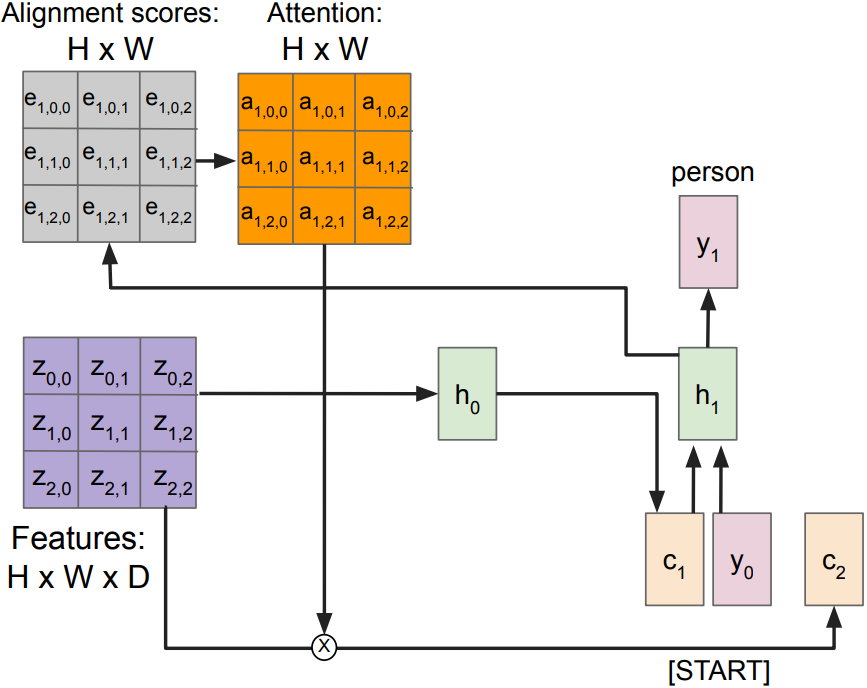
Each timestep of decode uses a different context vector that looks(attend) at different parts of the input image. This entire process is differentiable; model chooses its own attention weights. No attention supervision is required.
Similar tasks in NLP - Language translation example
Vanilla Encoder-Decoder setting:
- Input: sequence x $= x_1, x_2, \ldots, x_T$
- Output: sequence y $= y_1, y_2, \ldots, y_T$
- Encoder: $h_0 = f_W(z)$, where $z_t = \mbox{RNN}(x_t, u_{t-1})$, $f_W(\cdot)$ is MLP, u is the hidden RNN state
- Decoder: $y_t = g_v(y_{t-1}, h_{t-1}, c)$, where context vector c is often $c=h_0$
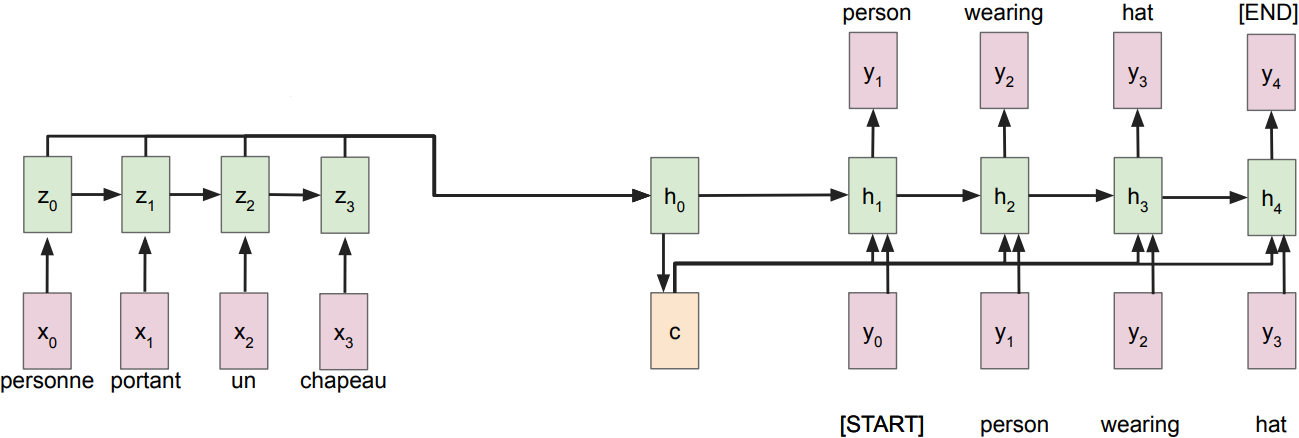
Attention in NLP
- Alignment scores(scalars):
$e_{t,i} = f_{\mbox{att}}(h_{t-1}, z_t)$, where $f_{\mbox{att}}(\cdot)$ is an MLP - Normalize to get attention weights:
$a_{t,:} = \mbox{softmax}(e_{t,:})$,
$0<a_{t,i}<1$, attention values sum to 1 - Compute context vector c:
$c_t = \sum_i a_{t,i} z_{t,i}$ - Decoder: $y_t = g_v(y_{t-1}, h_{t-1}, \color{red}c_t)$
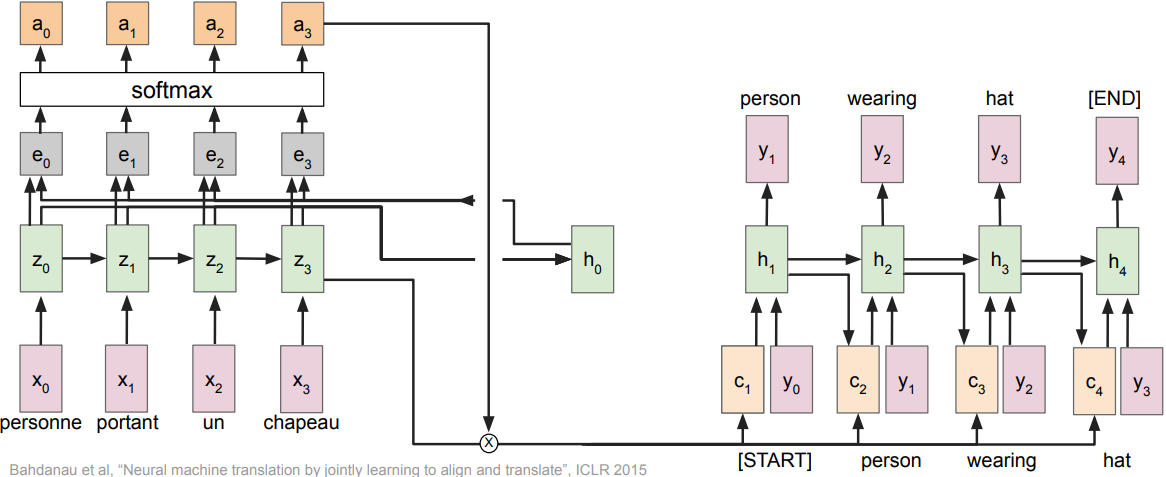
Heatmap: visualization of attention weights; without any attention supervision, model learns different word orderings for different languages
General Attention Layer
Attention in image captioning before
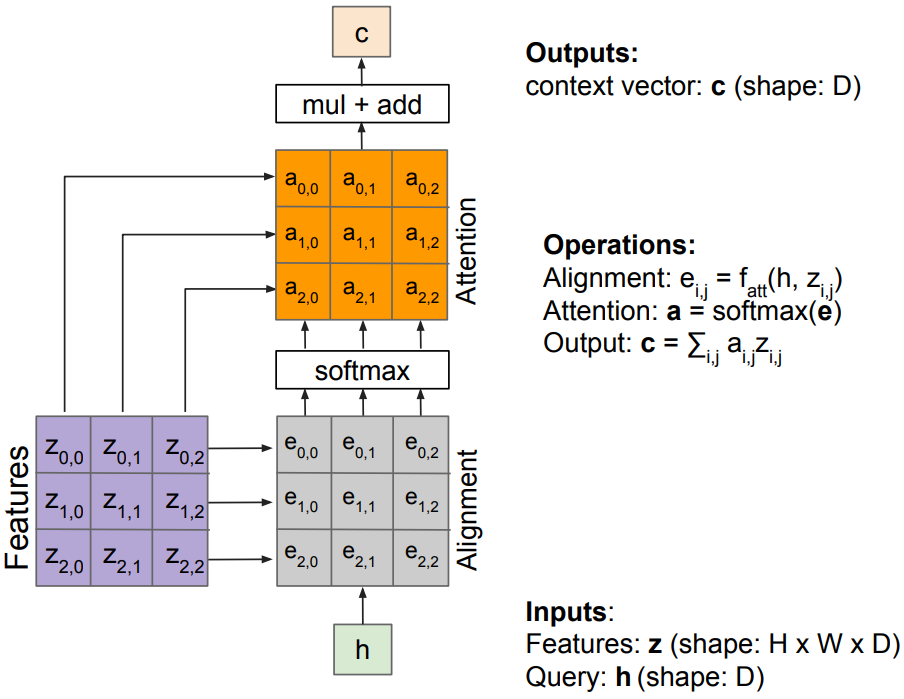
Single query setting
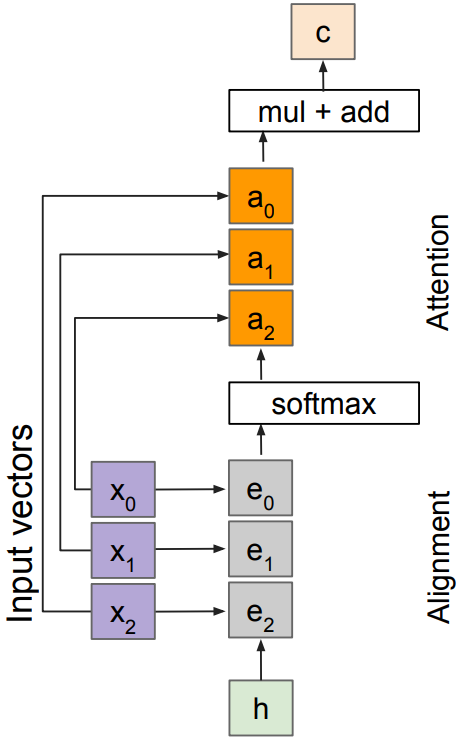
Inputs
- input vectors: x(shape: $N\times D$)
Attention operation is permutation invariant; produces the same output regardless of the order of elements(features) in the input vector. Stretch $H\times W = N$ into N vectors, transform $H\times W\times D$ features into $N\times D$ input vectors x(similar to attention in NLP). - Query: h(shape: D)
Operations
- Alignment
- Change $f_{\mbox{att}}(\cdot)$ to a simple dot product:
$e_i = h\cdot x_i$; only works well with key & value transformation trick - Change $f_{\mbox{att}}(\cdot)$ to a scaled dot product:
$e_i = h\cdot x_i / \sqrt{D}$;
Larger dimensions means more terms in the dot product sum. So, the variance of the logits is higher. Large magnitude(length) vectors will produce much higher logits. Then, the post-softmax distribution(e) has lower-entropy(high uncertainty) assuming logits are I.I.D. Ultimately, these large magnitude vectors will cause softmax to peak and assign very little weight to all others. To reduce this effect, divide by $sqrt{D}$.
- Change $f_{\mbox{att}}(\cdot)$ to a simple dot product:
- Attention: $\mathbf{a} = \mbox{softmax}(\mathbf{e})$
- Output: $\mathbf{c} = \sum_i a_i x_i$
Outputs
- context vector: c(shape: D)
Multiple query setting
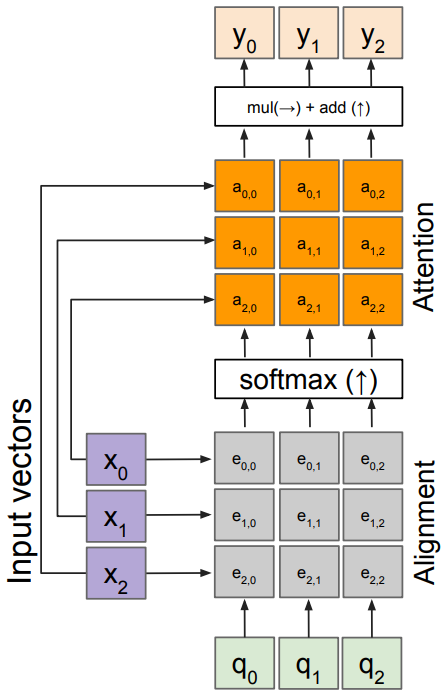
Inputs
- input vectors: x(shape: $N\times D$)
- Queries: q(shape: $M\times D$); multiple query vectors
Operations
- Alignment: $e_{i,j} = q_j\cdot x_i / \sqrt{D}$
- Attention: $\mathbf{a} = \mbox{softmax}(\mathbf{e})$
- Output: $y_j = \sum_i a_{i,j} x_i$
Outputs
- context vectors: y(shape: D);
each query creates a new output context vector
Weight layers added
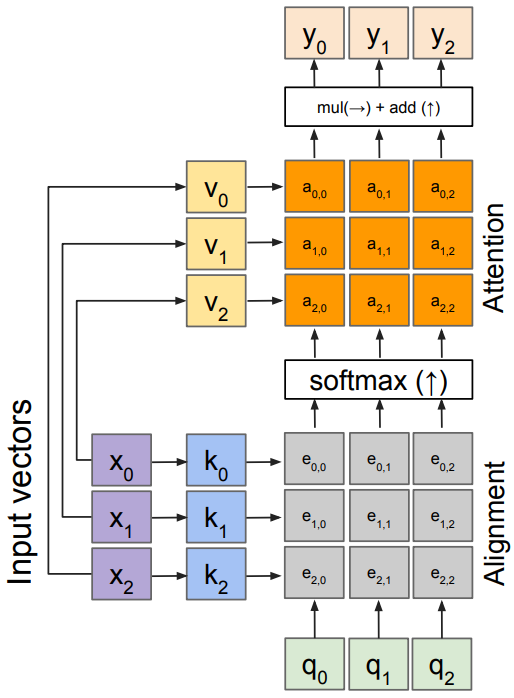
Notice that the input vectors x are used for both the alignment(e) and attention calculations(y); We can add more expressivity to the layer by adding a different FC layer before each of the two steps. The input and output dimensions can now change depending on the key and value FC layers.
Inputs
- input vectors: x(shape: $N\times D$)
- Queries: q(shape: $M\times D_k$)
Operations
- Key vectors: $\mathbf{k} = \mathbf{x}W_k$
- Value vectors: $\mathbf{v} = \mathbf{x}W_v$
- Alignment: $e_{i,j} = q_j\cdot k_i / \sqrt{D}$
- Attention: $\mathbf{a} = \mbox{softmax}(\mathbf{e})$
- Output: $y_j = \sum_i a_{i,j} v_i$
Outputs
- context vectors: y(shape: $D_v$);
Self attention layer
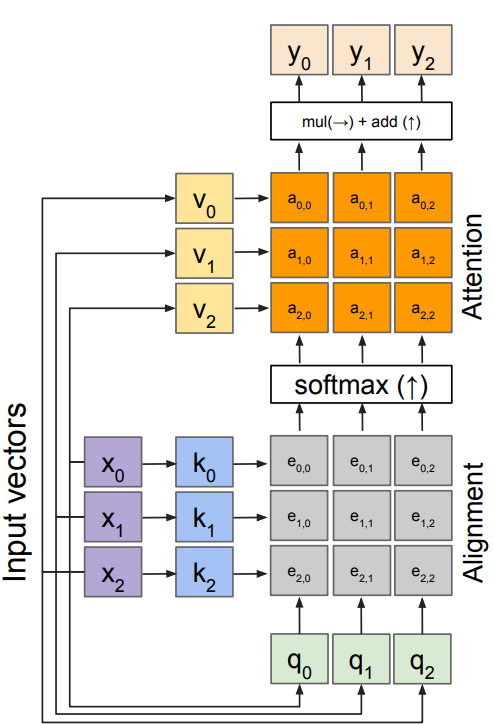
Recall that the query vector was a function of the input vectors; Encoder $h_0=f_W(z)$, where z is spatial CNN features, $f_W(\cdot)$ is an MLP. We can calculate the query vectors from the input vectors, defining a “self-attention” layer. No input query vectors anymore, instead query vectors are calculated using a FC layer.
Inputs
- input vectors: x(shape: $N\times D$)
Operations
- Key vectors: $\mathbf{k} = \mathbf{x}W_k$
- Value vectors: $\mathbf{v} = \mathbf{x}W_v$
- Query vectors: $\mathbf{q} = \mathbf{x}W_q$
- Alignment: $e_{i,j} = q_j\cdot k_i / \sqrt{D}$
- Attention: $\mathbf{a} = \mbox{softmax}(\mathbf{e})$
- Output: $y_j = \sum_i a_{i,j} v_i$
Outputs
- context vectors: y(shape: $D_v$)
Positional encoding
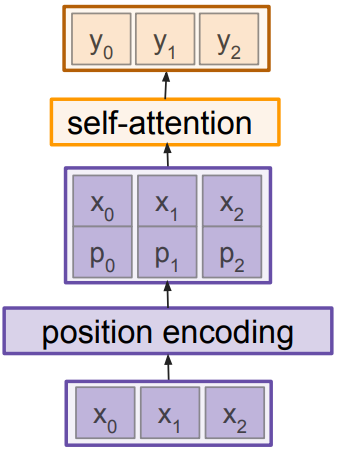
Self attention attends over sets of inputs; is permutation invariant. To encode the ordered sequences(e.g. language, image), concatenate special positional encoding $p_j$ to each input vector $x_j$.
$\mathit{pos}: N\rightarrow R^d$ to process the position j of the vector into a d-dimensional vector; $p_j = \mathit{pos}(j)$
Desiderata of $\mathit{pos}(\cdot)$:
- Should output a unique encoding for each time-step(word’s position in a sentence).
- Distance between any two time-steps should be consistent across sentences with different lengths(variable inputs).
- Model should generalize to longer sentences without any efforts. Its values should be bounded.
- Must be deterministic.
Options for $\mathit{pos}(\cdot)$:
- Learn a lookup table:
- Learn parameters to use for $\mathit{pos}(t)$ for $t \in [0,T)$
- Lookup table contains $T\times d$ parameters
- Design a fixed function with the desiderata
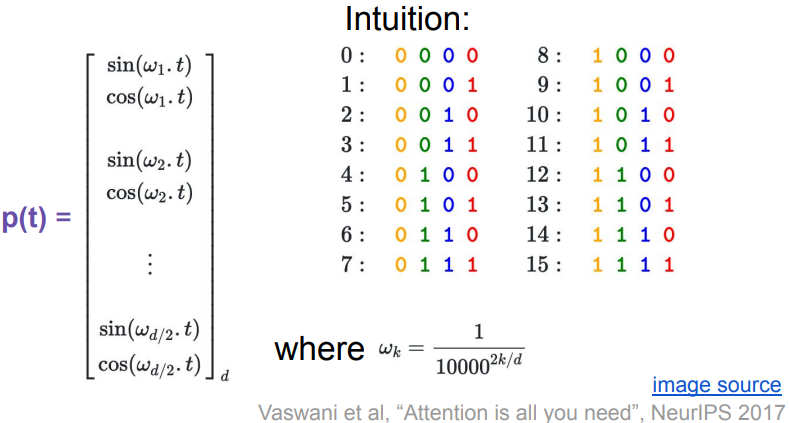
Masked self-attention layer
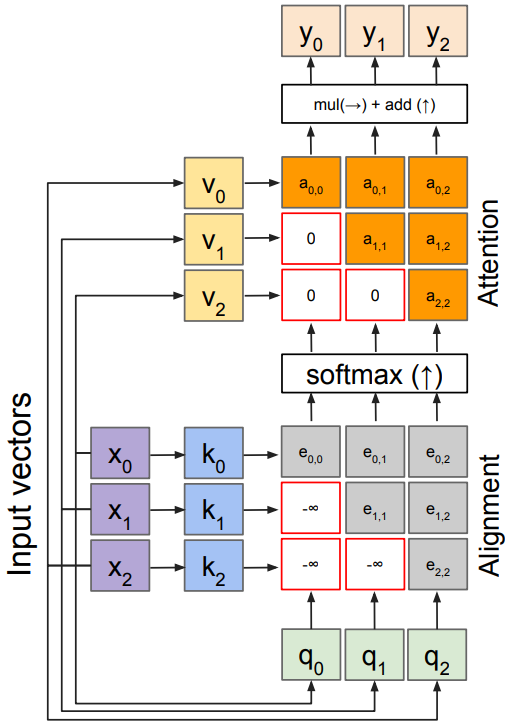
Manually set alignment scores to $-\infty$, prevent vectors from looking at future vectors.
Multi-head self attention layer
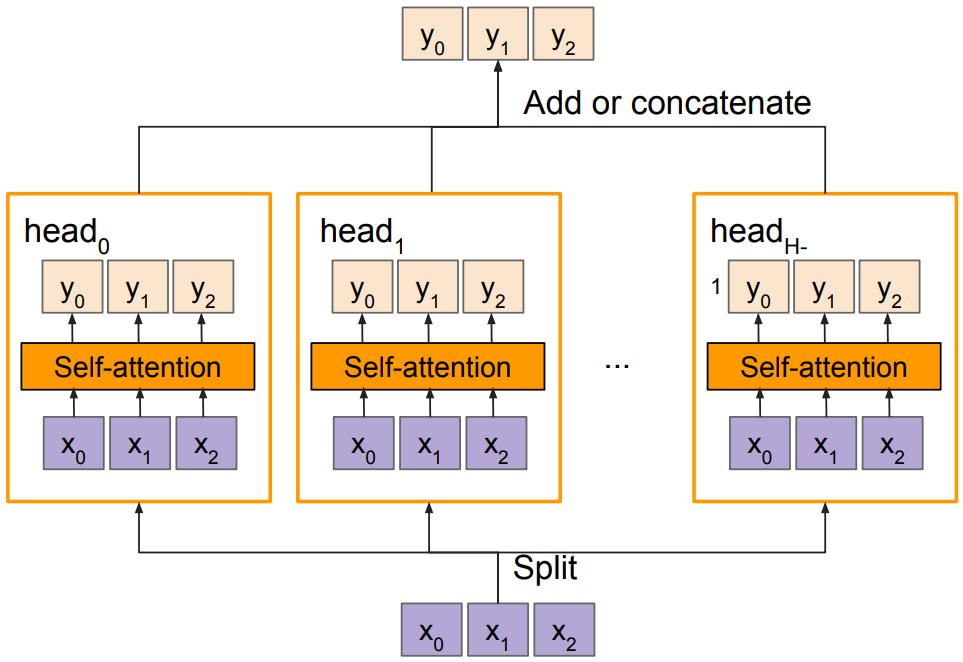
Multiple self-attention heads in parallel; similar to ensemble
Comparing RNNs to Transformers
RNNs
(+) LSTMs work reasonably well for long sequences.
(-) Expects an ordered sequences of inputs
(-) Sequential computation: subsequent hidden states can only be computed after the previous ones are done.
Transformers
(+) Good at long sequences. Each attention calculation looks at all inputs.
(+) Can operate over unordered sets or ordered sequences with positional encodings.
(+) Parallel computation: All alignment and attention scores for all inputs can be done in parallel.
(-) Requires a lot of memory: N x M alignment and attention scalers need to be calculated and stored for a single self-attention head.
Transformers
Image Captioning using transformers

- No recurrence at all
Input: Image I
Output: Sequence y $= y_1, y_2, \ldots, y_T$
Encoder: $c = T_W(z)$, where z is spatial CNN features, $T_W(\cdot)$ is the transformer encoder
Decoder: $y_t = T_D(y_{0:t-1}, c)$, where $T_D(\cdot)$ is the transformer decoder
The Transformer encoder block
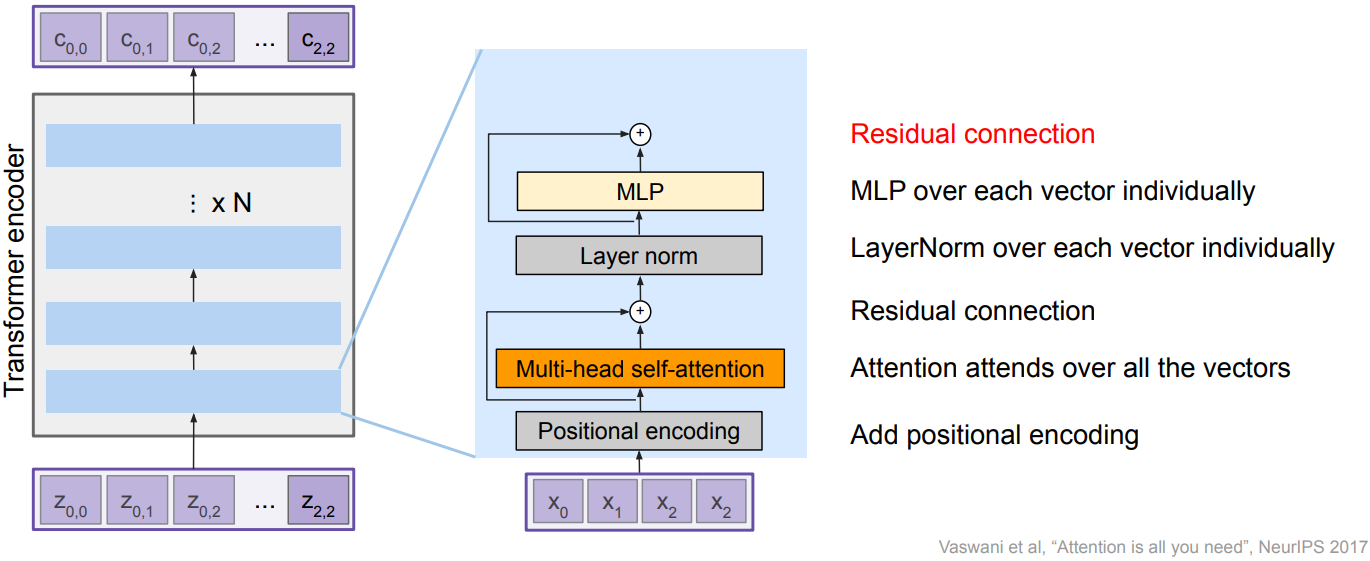
Inputs: Set of vectors x
Outputs: Set of vectors y
Self-attention is the only interaction between vectors; Layer norm and MLP operate independently per vector. Highly scalable, highly parallelizable, but high memory usage.
The Transformer Decoder block
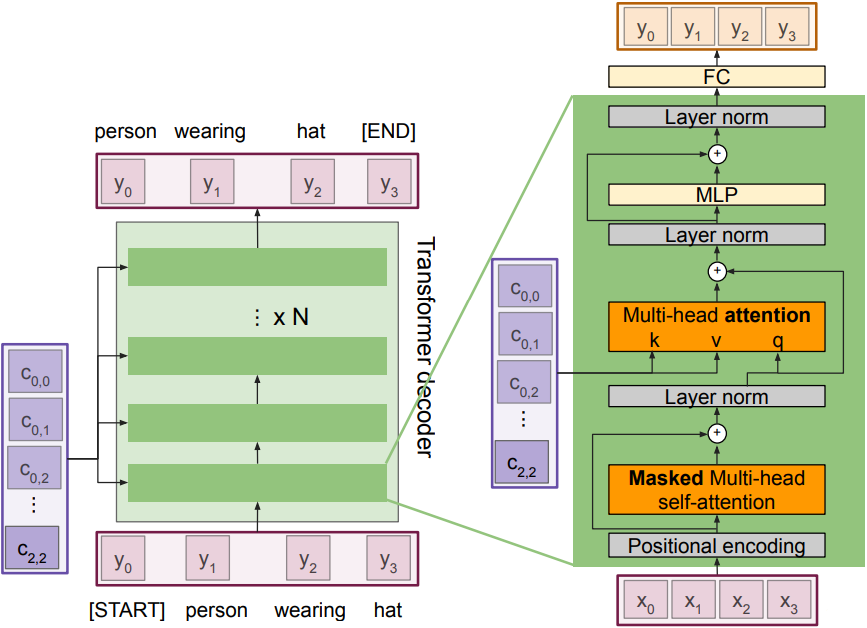
Inputs: Set of vectors x and Set of context vector c
Outputs: Set of vectors y
Masked Self-attention only interacts with past inputs(x, or previous output $y_{t-1}$). Multi-head attention block is NOT self-attention; it attends over the transformer encoder outputs. In this phase, we inject image features into the decoder. Highly scalable, highly parallelizable, but high memory usage.
Image Captioning using ONLY transformers
-
Transformers from pixels to language
Dosovitskiy et al, “An Image is Worth 16x16 Words: Transformers for Image Recognition at Scale”, ArXiv 2020 colab notebook link -
Note: in Google Colab - TPU runtime setting
import tensorflow as tf
import os
# TPU initialization
resolver = tf.distribute.cluster_resolver.TPUClusterResolver(tpu='grpc://' + os.environ['COLAB_TPU_ADDR'])
tf.config.experimental_connect_to_cluster(resolver)
tf.tpu.experimental.initialize_tpu_system(resolver)
strategy = tf.distribute.TPUStrategy(resolver)
# compile in strategy.scope
def create_model():
return tf.keras.Sequential(
[tf.keras.layers.Conv2D(256, 3, activation='relu', input_shape=(28, 28, 1)),
tf.keras.layers.Conv2D(256, 3, activation='relu'),
tf.keras.layers.Flatten(),
tf.keras.layers.Dense(256, activation='relu'),
tf.keras.layers.Dense(128, activation='relu'),
tf.keras.layers.Dense(10)])
with strategy.scope():
model = create_model()
model.compile(optimizer='adam',
loss=tf.keras.losses.SparseCategoricalCrossentropy(from_logits=True),
metrics=['sparse_categorical_accuracy'])
Summary
- Adding attention to RNNs allows them to “attend” to different parts of the input at every time step
- The general attention layer is a new type of layer that can be used to design new neural network architectures
- Transformers are a type of layer that uses self-attention and layer norm.
- It is highly scalable and highly parallelizable
- Faster training, larger models, better performance across vision and language tasks
- They are quickly replacing RNNs, LSTMs, and may even replace convolutions.